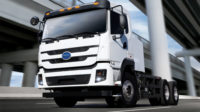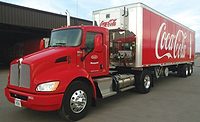2024 Trucks Report: Delivery fleet manufacturers continue to put more of their eggs into the electric basket
Trucks manufacturers equip vehicles with latest software, improved ergonomics

Original equipment manufacturers (OEMs) continue to pour much of their energy — no pun intended — into developing and promoting their entries into the electric vehicle (EV) realm, with a disproportionate amount of the news coming out of the major truck manufacturers being focused on the zero-emissions space.
It’s remarkable considering that right now, the number of EVs currently operating in the field is a mere fraction of more traditionally powered vehicles. But, by definition, plans aren’t so much about the present as they are about the future and fleet equipment suppliers are betting big on the notion that the future is an electrified one. Here’s what’s been happening at some of the majors’ production facilities.

Daimler/Rizon
Earlier this year, Daimler Truck launched its newest brand, Rizon, which offers a line of medium-duty electric trucks for the U.S. market and, in October, received full approval to sell Rizon vehicles nationwide.
The company initially is offering three model variants for its Class 4 and 5 vehicles, the e18L, e16L and e16M. The Class 4 and 5 medium-duty battery-electric vehicles, ranging from 15,995 up to 17,995 pounds in gross vehicle weight (GVW), are able to run from 110-160 miles for L size variant with three battery packs) and 75-110 miles (for M size variant with two battery packs) on a single charge.
All Rizon trucks are built using proven quality assurance standards developed by Daimler Truck and in practice at more than 40 manufacturing locations around the world. They’re suitable for urban and last-mile deliveries and support a wide mix of configurations to suit a fleet’s requirement, including box and refrigerated trucks.
The Rizon trucks recently received both Environmental Protection Agency (EPA) certification and dual CARB executive orders and is in full compliance with the U.S. Federal Motor Vehicle Safety Standards. The first deliveries of vehicles are set to commence imminently through dealer networks in California. With the vehicle certification via CARB Executive Orders, customers in California can take advantage of a $60,000 baseline incentive for each vehicle through the California Air Resource Board’s (CARB) Hybrid and Zero-emission Truck and Bus Voucher Incentive Project (HVIP).
RIZON trucks are exclusively distributed by Velocity EV, which is a part of the Velocity Vehicle Group.

Daimler/Freightliner
In other major Daimler news, the company announced in late October that it had begun production of the Freightliner eM2 medium-duty battery electric truck. The eM2 is being manufactured at Daimler Truck North America’s plant in Portland, Ore., and is built on the Freightliner M2 106 Platform. It follows the introduction of the battery electric Freightliner eCascadia last year.
The eM2 features a proprietary, fully integrated, battery electric Detroit ePowertrain. Its streamlined design places electric motors and a two-speed transmission directly on the drive axles, resulting in minimized energy cost per mile. The driving range varies based on the two available battery capacity options for the eM2. The Class 6 single-motor model provides up to 190 continuous horsepower, a 194 kWh battery, and a typical range of 180 miles (290 kilometers) on a single charge. In contrast, the Class 7 dual-motor variant offers up to 255 continuous horsepower, supported by a 291 kWh battery, providing a typical range of 250 miles (400 kilometers) on a single charge.
Standard safety features now include active brake assist 5 (ABA5), tailgate warning, adaptive cruise control (ACC) down to zero mph, lane departure warning, intelligent high-beams, automatic wipers/headlamps, and side guard assist. The eM2 is further enhanced by Detroit Connect, a connected vehicle solution that facilitates real-time monitoring of battery health, charging status, and energy usage. This connectivity enables efficient route planning, energy optimization, and post-trip data analysis to improve overall energy efficiency.

Navistar
Navistar has plenty of its own EV updates to share, including the delivery this year of the first international eMV series with ePower to global foodservice distribution giant Sysco.
With the availability of the factory-installed ePower and electric power take-off (ePTO) electrical system options, beverage delivery fleets now have the ability to spec International eMV Series Class 6 and 7 battery electric trucks for additional market applications.
The ePower option pulls power directly from the electric vehicle’s battery pack and is the foundation for electric transport refrigeration unit (eTRU) applications.
Navistar also announced a partnership with infrastructure solutions company Quanta Services, Inc. Through the partnership, Navistar will provide International customers with a comprehensive vehicle and charging infrastructure solution that enables fleets to implement battery-electric vehicles quickly and efficiently.
The agreement with Quanta will capitalize on Navistar’s three-step approach to delivering fully integrated eMobility solutions to customers: consulting, charging and deployment. Together, Navistar and Quanta will analyze, forecast, plan and execute across customers’ electrification journey. Navistar’s EV consulting process begins with establishing an EV roadmap for customers by hosting discovery workshops designed to understand fleet needs and concerns around electrification.
Navistar also works to determine hardware and charging depot locations for each individual fleet. When EVs are ready to be deployed, connected technology plays a large role in ensuring the best use cases and optimal operation. Navistar’s OnCommand Connection technology allows for advanced remote diagnostics and the ability to turn vehicle health data into actionable insights, allowing for greater uptime and lower total cost of ownership.

Hino
Hino is expanding its offerings to include electric versions of its M- and L-Series medium-duty trucks known as the Me Series and Le Series, to be available in 2024. The manufacturer is integrating SE Electric’s SEA-Drive power system into the electrified models. The Hino Class 5 M5e cabover and Class 6 L6e conventional models come equipped with battery capacities of 138kwH and 220kwH respectively.
The company signed a distribution agreement with Hexagon Purus for its EVs.
In other Hino news, the OEM this year concluded a memorandum of understanding with Daimler Truck, Toyota Motor Corp. and Mitsubishi Fuso on accelerating the development of advanced technologies and merging Mitsubishi Fuso and Hino. The companies intend to promote the use of environmentally friendly vehicles and increase the value of mobility across the world. The Hino and Mitsubishi merger creates synergies that enhance the competitiveness of Japanese truck manufacturers.

Isuzu
To support the imminent arrival of its first electric truck, Isuzu Commercial Truck of America, appointed ChargePoint, a provider of networked solutions for charging EVs, as an official source to provide EV charging infrastructure and software solutions, as well as training for dealers and customers.
The infrastructure agreement follows the announcement earlier in the year that it is releasing the 2025 NRR EV, a Class 5 battery electric vehicle, in early 2024. Dealers would need to access a ChargePoint web portal using the dealer’s own secure channels. ChargePoint will then work with the dealer and/or customer directly to develop a customized electrification solutions and identify available incentives from local and state agencies and utilities.
The NRR EV, a 19,500-pound GVWR Class 5 truck offers four choices of battery capacity, the largest of which has a range up to about 235 miles, as well as AC and DC fast-charging capabilities. The wheelbases range from 132.5 to 176 inches to accommodate a variety of body lengths, and an upgraded cab features a new front end and a completely new dash design and layout with a new interior color scheme. Customers can choose from three-, five-, seven- and nine-battery pack models, with each pack holding 20-kilowatt-hour lithium ion batteries. The number of battery packs chosen will ultimately determine the truck’s driving range.
There’s also an optional advanced driver assistance system package designed to improve driver, passenger and pedestrian safety and help reduce the number and severity of collisions. Standard on every N-Series EV will be a multi-information display that will include warning lights, status indicators of driver assistance features, time and temperature displays, odometer, fuel gage, shift position indicator and more.
Other interior features include auto-on/off headlamps, electrically operated climate controls, variable intermittent windshield wipers, electronic parking brand and driver’s seat arm rest. All models will feature three-across seating, with new urethane cushions and upholstery.

Volvo
In September, Coke Canada Bottling became the latest beverage operation to incorporate Volvo VNY electric trucks into its fleet, as part of the bottler’s Toward a Better Future Together sustainability action plan. The trucks will contribute to the company’s goal of reducing carbon emissions from direct sources and supplied energy by 46.2% by 2030.
The VNR electric trucks feature a six-battery configuration that can cover up to 275 miles on one charge as the trucks make several daily round trips of 150 km (93 miles) from the beverage company’s distribution center in Montreal to customer locations throughout the region. Coke Canada Bottling also installed three 150 kW DC chargers with nine dispensers at its Montreal Distribution Center to support drive-through charging for the Volvo VNR Electric trucks. The trucks have a battery capacity of 565 kilowatt hours and can obtain an 80% charge in just 90 minutes.
Volvo also recently unveiled its all-in-one fleet management portal, Volvo Connect, which provides a digital suite of state-of-the-art services, analytics, and reports that deliver fleets a range of truck data, including fuel consumption, idle time, vehicle speed, seat belt information, and location information.
Volvo Connect helps companies ensure that their fleet is maximizing efficiency and profitability with all trucks operating at peak performance. Volvo Connect allows fleet managers to access the status of all Volvo trucks in their fleet that have a factory-installed 4G telematics gateway.
The portal provides the ability to check and monitor that parameters such as maximum allowed road speed and idle shutdown are set correctly and optimized for a truck’s specific transport assignment. Volvo Connect provides Remote Diagnostics and Remote Programming visibility, making it easy to identify trucks that have fault events that need to be addressed, as well as any over-the-air software updates that are available to help ensure trucks are fully updated and operating at peak performance.
BYD
BYD Motors announced that it has formed a service partnership with Cox Automotive covering BYD customers’ fleets of Class 6 and 8 trucks in the U.S. market, offering round-the-cloud roadside support and a network of EV-trained service technicians.
Currently, BYD has more than 500 trucks already in operation across the country and Cox has nearly 40 locations in the U.S., with a team of more than 1,400 technicians ready to service those vehicles.
Earlier this year BYD delivered an 8Y terminal tractor to Manhattan Beer Distributors in New York. It’s the first electric terminal tractor in the company’s fleet of more than 355 trucks (which includes the aforementioned Volvo VNR). The BYD 8Y terminal tractor can provide 22 to 26 hours of consecutive operation.
Mercedes-Benz USA
Mercedes-Benz USA has announced pricing for its all-new eSprinter, the company’s first fully electric van in the North America market. Prices start at $71,886 for the vehicle, which offers a range of up to nearly 250 miles.
The eSprinter will be available as a 170-inch wheelbase cargo van with a high roof, sporting a 113 kilowatt hour battery. When charging at a wallbox, the on-board AC charger has a maximum charging power of 9.6 kilowatts, while the standard maximum charging power at DC fast-charging stations is up to 50 kilowatts. With the optional upgrade, DC fast charging is available up to 115 kilowatts, allowing the battery to charge from approximately 10% to 80% in just more than 40 minutes.
The electric powertrain features two new developments, the efficient motor and the innovative electric rear axle, both of which are featured for the first time in a battery-electric van from Mercedes-Benz. The permanent magnet synchronous motor, which weighs about 286 pounds, is characterized by particularly high efficiency and optimized thermal management. The motor is available in two power levels, with 100 or 150 kilowatts of peak output. Both deliver a torque of up to 295 pounds per feet for at least 30 seconds.
Inside, the optional Mercedes-Benz User Experience (MBUX) features a system based on artificial intelligence and an intuitive operating system. MBUX can be operated by voice control, the touchscreen and touch control buttons on the standard multifunctional steering wheel.
The system has learning capabilities and intelligent voice control with natural language understanding and a verbal cue of “hey Mercedes.” Optional Navigation with “Electric Intelligence” helps ensure the best possible planning certainty. For example, it updates the range in real time depending on the current traffic situation and the topography of the route. It also calculates the best possible charging strategy to get to the destination as quickly as possible, or to have the desired state of charge (SoC) at the destination.
The optional digital rear view mirror offers the driver unobstructed views of the rear and a distinct advantage when in reverse. With this option, the conventional rear-view mirror installed on the windshield also serves as a digital rear-view mirror, transmitting an image from a High Dynamic Range camera installed in the exterior rear end of the roof. The mirror is equipped with light sensors at the front and rear and automatically adjusts the brightness of the display to ambient conditions.

Ford
One of the other major manufacturers of delivery vans, Ford, is spearheading research into the potential for hydrogen as an on-board energy source for its E-Transit all-electric commercial vehicle. The UK-based project will establish if hydrogen fuel cell technology can help to deliver enhanced zero-emission-driving range for E-Transit customers with energy-intensive use cases.
Part-funded by the Advanced Propulsion Centre (APC), Ford’s consortium of six automotive technology leader and fleet operator partners also will help to determine the supporting hydrogen re-fueling infrastructure required.
Hydrogen fuel cells produce electricity by combining hydrogen from an onboard tank and oxygen, with the only resulting emissions being water. The system essentially uses the hydrogen tank as a “gas battery” to improve range and deliver faster charging than the solid batteries and mains-connected chargers typically used by EVs.
A test fleet of eight hydrogen fuel cell Ford E-Transits will run for six-month periods over the three-year project to 2025. The test fleet data will provide insights into the total cost of owning and operating a large van with enhanced zero-emission range and uptime that matches a diesel-powered equivalent.
The prototype Ford E-Transits will be fitted with a high-power fuel cell stack, in conjunction with significant hydrogen storage capability, optimized for safety, capacity, cost and weight. An important project element will evaluate efficient and viable recycling for end-of-life components.
PACCAR
Kenworth, a PACCAR company, recently announced that the latest version of its Advanced Driver Assistance System (ADAS), is now available for its T680 models.
Enhancements, part of the Bendix Fusion system, include Adaptive Cruise Control Stop and Auto Go. When a commercial truck follows a lead vehicle in cruise control, this enhancement enables the system to apply braking to maintain a pre-set following distance and will bring the truck to a complete stop, if necessary, and will hold the truck in place. When the truck can move forward, it will automatically accelerate to the vehicle set speed without driver intervention and maintain a safe following distance.
In the event a truck departs the roadway, the new Highway Departure Braking to Zero feature will provide an audible chime and apply braking to reduce vehicle speed if the vehicle begins departing the roadway. In some circumstances, the system may reduce the vehicle speed to a full stop until the driver re-engages. Additionally, Kenworth celebrated its 100th anniversary in 2023.
Another major PACCAR brand, Peterbilt, announced that its model 589 now is available for customer orders, with delivery anticipated for summer 2024. The includes a robotically assembled cab, an aluminum hood, wrap-around grille crown with triple bars, rectangular grille mesh, and the signature bird ornament — all features that are reminiscent of classic Peterbilt trucks. Other exterior features include bold 15-inch air cleaners, 7-inch exhaust stacks and exhaust shield, and Peterbilt’s distinguished exterior lighting package, with LED daytime fender-brace running lights for a stunning front-end look.
The styling of the 589 is supported by advanced engineering and technologies that provide maximum performance and uptime, including features such as an air-assisted hydraulic clutch on manual transmissions, which reduces driver fatigue and maintenance, and the latest collision mitigation for improved driver safety. It also features advanced driver technology, and other features like predictive cruise control are incorporated to lessen the environmental impact of a traditional truck.
The 589 is the successor to the model 389, which enjoyed a bit of its own news in 2023. This year it achieved a major milestone: The 100,000th model 389 completed production at Peterbilt’s Denton, Texas-based manufacturing plant in September. The 389 will end its run at the close of this year and the 589 will begin in January.
Looking for a reprint of this article?
From high-res PDFs to custom plaques, order your copy today!





